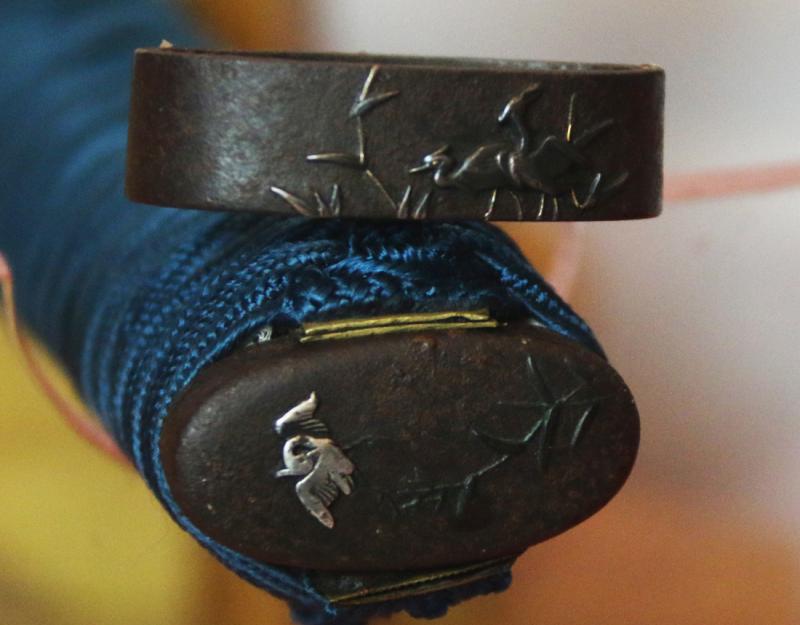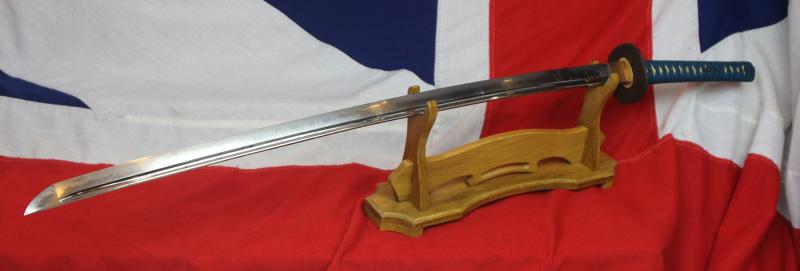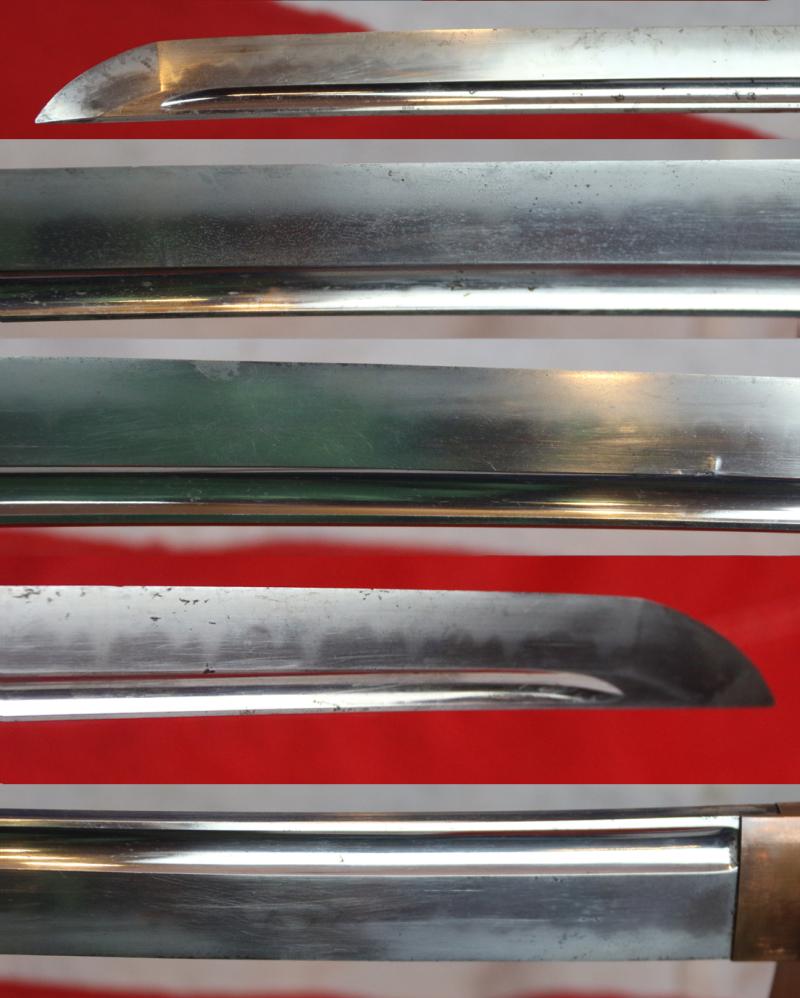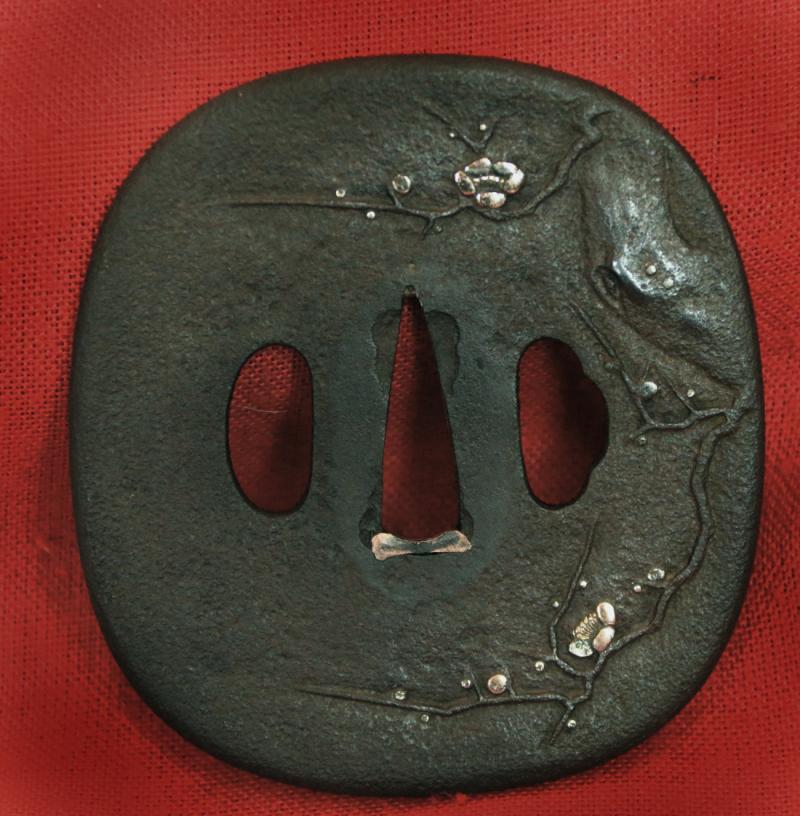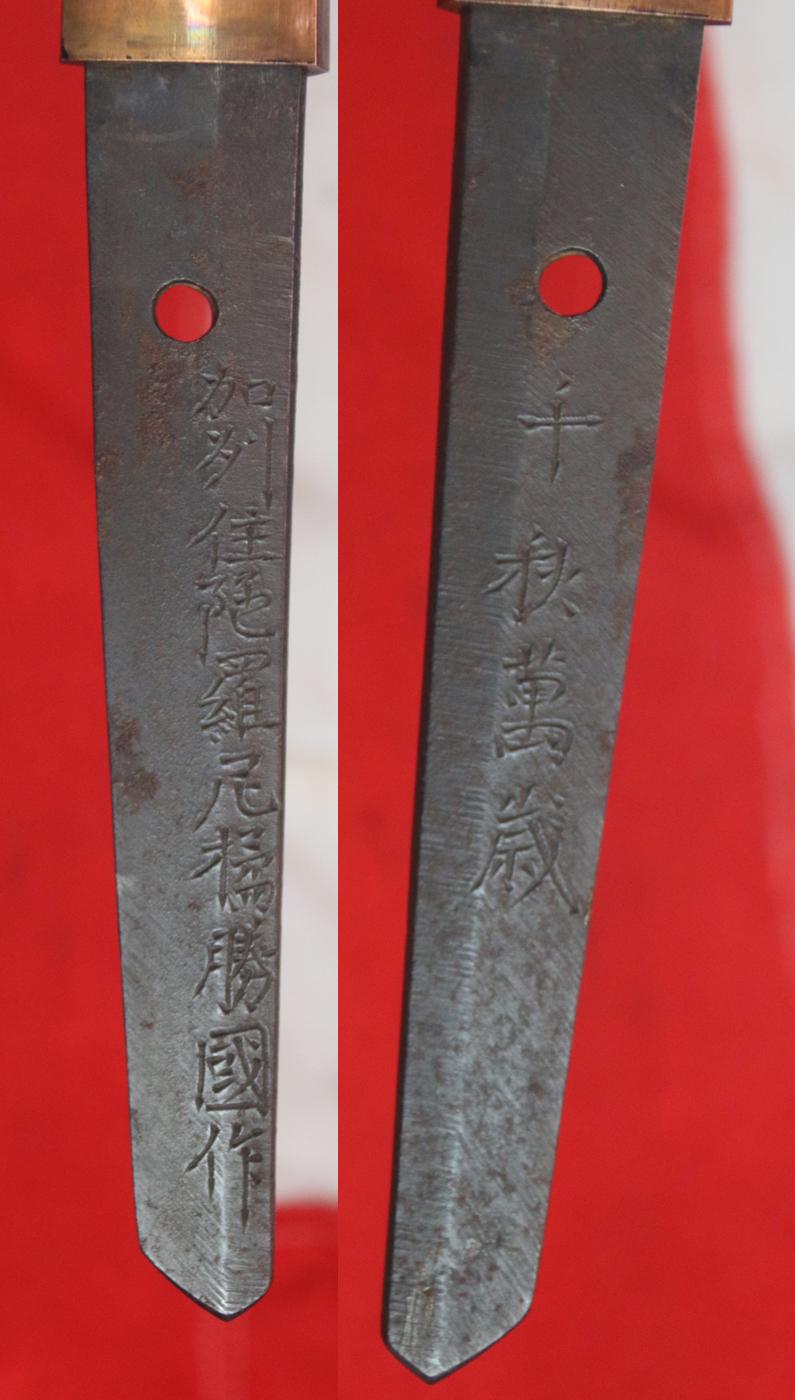Stunning,1600's 'Senshu Banzai' Antique Edo Samurai Katana With Signed Blade, Kashu ju Darani Tachibana Katsukuni Saku, Katsukuni of the Tachibana Clan, the Darani School of Smiths, Made This {Sword} in Kashu Province, Incredible Hamon of Sanbon-Sugi
Beautifully mounted in original Edo mounts of iron fuchi kashira of silver birds in reeds, a pair of takebori crab menuki, with a fine iron tsuba decorated with takebori prunus blossom in silver, upon their branches. Finest blue tsukaito binding, and a beautiful black lacquer saya carved buffalo horn kurigata and dark brown sageo.
Signed blade,
加州住陀羅尼橘勝國作
Kashu ju Darani tachibana Katsukuni saku.
The Darani school, was geographically located in the Kaga domain, and its aim was following the Mino forging style. The sword's smith, likely the third generation, of the 1600’s, was a member, and made for, the Tachibana clan of Kashu {Kaga} province.
Engraved upon the ura with mei Senshu Banzai, which means ‘celebrate long life’, it may be for the samurai for whom it was made, or possibly to whom it was presented. A most unusual engraved Mei blessing to see chisseled upon a blade nakago
The Tachibana clan
Home province Chikuzen
Parent house Ōtomo clan
Founder Tachibana Sadatoshi (Ōtomo Sadatoshi)
Founding year 14th century
The Tachibana clan (立花氏) was a Japanese clan of daimyō (feudal lords) during Japan's Sengoku and Edo periods. Originally based in Tachibana castle in Kyūshū, the family's holdings were moved to the Yanagawa Domain in the far north-east of Honshū in the Edo period.
Darani Katsukuni swords are rated on the Wazamono list in the Kokon Kajibiko (古今鍛冶備考) of 1830 and later additions, as
Yoki Wazamono (良業物), {Ryo Wazamono } "Very good." Swords that cut through the torso 5-7 out of 10 times.
Edo period 1597 to 1863
The head of Darani school - Katsukuni 勝国 followed Mino technique and made to emulate Sanbon-sugi hamon {three cedar pattern} of Kanemoto
Wazamono is a classification of Japanese swords and swordsmiths used in Japan to identify historic blades of exceptional quality. According to the first edition of Kaiho Kenjaku (懐宝剣尺) published in 1797, There are 163 Wazamono swords in total, grouped into four categories based on their quality. This rating is based on a book compiled by Yamada Asaemon V (山田浅右衛門吉睦), an official sword cutting ability examiner and executioner of the Tokugawa shogunate, and is an authoritative index of cutting ability of Japanese swords. The list of ratings concerning swordsmithing differs between Kaiho Kenjaku (懐宝剣尺) published in 1797 and the reprinted edition published in 1805, and the major revised edition of Kokon Kajibiko (古今鍛冶備考) published in 1830. Adding to the number of sword smiths in each edition: Saijo Ō Wazamono 15, Ō Wazamono 21, Yoki Wazamono 58, Wazamono 93, lower 3 grade mixed 65. In the original list of 1797 Twelve swords are classified as Saijō Ō Wazamono (Supreme Grade), twenty-one swords are classified as Ō Wazamono (Excellent), fifty swords are classified as Yoki (Ryō) Wazamono (Very Good), and eighty swords are classified as Wazamono (Good).
There was a most famous sword of the Tachibana it was named Raikiri: The Lightning Cutter, or Thunder Cutter.
Raikiri, also known as the Lightning Cutter, holds a place of honour within the annals of Japanese sword lore. Its story intertwines with the remarkable warrior Bekki Dōsetsu, the first head of the Tachibana family.
Originally, Raikiri began its existence as a long tachi sword named “Chidori.”
One fateful day, as Dōsetsu rested beneath a grand tree, a thunderbolt struck nearby. Swift as lightning, he drew his sword, Chidori, and slashed at the electrifying force.
The blade’s swift and decisive cut earned it a new name: Raikiri, signifying the lightning’s cleaving power.
Dōsetsu, father of the renowned Tachibana Ginchiyo, wielded Raikiri with unmatched skill. His valour and connection to the supernatural elevated the sword’s status.
Raikiri became a symbol of courage, a blade that could slice through not only flesh but also the very elements.
The katana was such a crucial part of a samurai's life that when a young warrior was on the verge of entering this world, the sword he would use as a protector was brought into the delivery room as if to greet the young one. And, when a weathered, old veteran warrior was on his deathbed, ready to cross over into the White Jade Pavilion of the afterlife, his katana was placed at his side, as if to protect him one last time. Samurai endured for almost 700 years, from 1185 to 1867. Samurai families were considered the elite. They made up only about six percent of the population and included daimyo and the loyal soldiers who fought under them. Samurai means “one who serves."
Samurai were expected to be both fierce warriors and lovers of art, a dichotomy summed up by the Japanese concepts of bu to stop the spear exanding into bushido (the way of life of the warrior) and bun (the artistic, intellectual and spiritual side of the samurai). Originally conceived as away of dignifying raw military power, the two concepts were synthesized in feudal Japan and later became a key feature of Japanese culture and morality.The quintessential samurai was Miyamoto Musashi, a legendary early Edo-period swordsman who reportedly killed 60 men before his 30th birthday and was also a painting master. Members of a hierarchal class or caste, samurai were the sons of samurai and they were taught from an early age to unquestionably obey their mother, father and daimyo. When they grew older they were trained by Zen Buddhist masters in meditation and the Zen concepts of impermanence and harmony with nature. The were also taught about painting, calligraphy, nature poetry, mythological literature, flower arranging, and the tea ceremony.
As part of their military training, it was said, that samurai were taught to sleep with their right arm underneath them so if they were attacked in the middle of the night and their the left arm was cut off the could still fight with their right arm. Samurai that tossed and turned at night were cured of the habit by having two knives placed on either side of their pillow. It seems somewhat extreme, but not entirely impossible.
Samurai have been describes as "the most strictly trained human instruments of war to have existed." They were expected to be proficient in the martial arts of aikido and kendo as well as swordsmanship and archery---the traditional methods of samurai warfare---which were viewed not so much as skills but as art forms that flowed from natural forces that harmonized with nature.
An individual didn't become a full-fledged samurai until he wandered around the countryside as begging pilgrim for a couple of years to learn humility. When this was completed they achieved samurai status and receives a salary from his daimyo paid from taxes (usually rice) raised from the local populace. Swords in Japan have long been symbols of power and honour and seen as works of art. Often times swordsmiths were more famous than the people who used them.
Antique Japanese woodblock prints in the gallery {not included} of Tachibana clan armour and Tachibana Masashige
Code: 25268
10950.00 GBP



